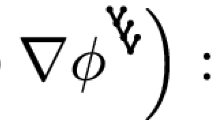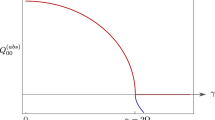We develop a Hamiltonian theory of a time dispersive and dissipative inhomogeneous medium, as described by a linear response equation respecting causality and power dissipation. The proposed Hamiltonian couples the given system to auxiliary fields, in the universal form of a so-called canonical heat bath. After integrating out the heat bath the original dissipative evolution is exactly reproduced. Furthermore, we show that the dynamics associated to a minimal Hamiltonian are essentially unique, up to a natural class of isomorphisms. Using this formalism, we obtain closed form expressions for the energy density, energy flux, momentum density, and stress tensor involving the auxiliary fields, from which we derive an approximate, “Brillouin-type,” formula for the time averaged energy density and stress tensor associated to an almost mono-chromatic wave.
Similar content being viewed by others
References
N. Akhiezer and I. Glazman, Theory of Linear Operators in Hilbert Space (Dover, New York, 1993).
Yu. Barash and V. Karpman, The ponderomotive force of a high-frequency electromagnetic field in media with spatial and frequency dispersion. Sov. Phys. JETP 58:1139 (1984).
A. Barut, Electrodynamics of and Classical Theory of Fields and Particles (Dover, 1980).
M. Born and E. Wolf, Principles of Optics (Pergamon, Oxford, 1993).
C. Chevalley, Theory of Lie Groups (Princeton University Press, Princeton, 1946).
L. Felsen and N. Marcuvits, Radiation and Scattering of Waves (Oxford University Press, Oxford, 1994).
A. Figotin and J. H. Schenker, Spectral theory of time dispersive and dissipative systems. J. Stat. Phys. 118:199–262 (2005).
A. Figotin and J. H. Schenker, Hamiltonian treatment of time dispersive and dissipative media within the linear response theory. Preprint, to appear, J. Comp. App. Math., physics/0410127.
A. Figotin and J. H. Schenker, Scattering theory for time dispersive and dissipative systems. In preparation.
J. Jackson, Classical Electrodynamics (John Wiley & Sons, New York, 1999).
D. Jones and G. Kentwell, On the stress tensor derivation of the time dependent ponderomotive force. Plasma Physics and Controlled Fusion 26(7):955–957 (1984).
Y. Jiang and M. Liu, Dynamics of dispersive and nonlinear media. PRL 77(6):1043–1046 (1966).
V. Jaksic and C.-A. Pillet, Spectral theory of thermal relaxation. J. Math. Phys. 38(4):1757–1780 (1997).
V. Jaksic and C.-A. Pillet, Ergodic properties of classical dissipative systems I. Acta Math. 181:245–282 (1998).
G. Kentwell and D. Jones, The time-dependent ponderomotive force. Phys. Reports 145(6):319–403 (1987).
A. Komech, M. Kunze and H. Spohn, Long-time asymptotics for a classical particle interacting with a scalar field. Comm. Partial Diff. Eq. 22:307–335 (1997).
R. Kubo, M. Toda and N. Hashitsume, Statistical Physics II, Nonequilibrium Stastical Mechanics, Second Edition (Springer-Verlag, Berlin, 1991).
H. Washimi and V. Karpman, The ponderomotive force of a high-frequency electromagnetic field in a dispersive medium. Sov. Phys. JETP 44:528 (1976).
H. Lamb, On a peculiarity of the wave-system due to the free vibrations on a nucleus in an extended medium. Proc. Lond. Math. Soc. XXXII:208–211 (1900).
C. Lanczos, The Variational Principles of Mechanics (Dover, 1970).
L. D. Landau and E. M. Lifshitz, The Classical Theory of Fields (Pergamon, Oxford, 1975).
L. D. Landau and E. M. Lifshitz, Electrodynamics of Continuous Media (Pergamon, Oxford, 1984).
M. Lax and D. F. Nelson, Linear and nonlinear electrodynamics in elastic anisotropic dielectrics. Phys. Rev. B 4:3694–3731 (1971).
P. Lax, Functional Analysis (Wiley-Interscience, New York, 2002).
P. Lax and R. Phillips, Scattering Teory (Academic Press, New York, 1967).
R. Loudon, L. Allen and D. F. Nelson, Propagation of electromagnetic energy and momentum through an absorbing dielectric, Phys. Rev. E 55:1071–1085 (1997).
J. E. Marsden and T. J. R. Hughes, Mathematical Foundations of Elastiticity (Dover, 1994).
J. E. Marsden and T. S. Ratiu, Introduction to Mechanics and Symmetry: A Basic Exposition of Classical Mechanical Systems (Springer, New York, 1999).
M. Mishchenko, J. Hovenier and L. Travis, Light Scattering by Nonspherical Particles. Theory, Measurements and Applications (Academic Press, San Diego, 2000).
P. Morse and H. Feshbach, Methods of Theoretical Physics (McGraw-Hill, New York, 1953).
M. A. Naimark, On a representation of additive operator set functions. C. R. (Doklady) Acad. Sci. URSS (N.S.) 41:359–361 (1943).
D. F. Nelson and B. Chen, Lagrangian treatment of magnetic dielectrics. Phys. Rev. B 50:1023–1038 (1994).
R. Newton, Scattering Theory of Waves and Particles (Dover, Mineola NY, 2002).
B. S. Pavlov, Spectral analysis of a dissipative singular Schrödinger operator in terms of a functional model. In M. A. Shubin (Ed.), Partial Differential Equations VIII, Encyclopaedia Math. Sci., Vol. 65 (Springer, Berlin, 1996, pp. 87–153).
B. S. Pavlov, Irreversibility, Lax-Phillips approach to resonance scattering and spectral analysis of non-self-adjoint operators In Hilbert space. International Journal of Theoretical Physics 38:21–45 (1999).
L. Pitaevskii, Sov. Phys. JETP 12:1008 (1961).
L. Ray-Bellet, Open Classical Systems. Lecture Notes of the 2003 Grenoble Summer School on Open Quantum Systems.
F. N. H. Robinson, Electromagnetic stress and momentum in matter. Phys. Repors, 6 (1975) 313–354.
M. Reed and B. Simon, Methods of Modern Mathematical Physics. I. Functional Analysis (Academic Press, New York-London, 1980).
B. Simon, Representations of Finite and Compact Lie Groups (AMS, Providence, 1996).
A. Sommerfeld, Electrodynamics (Academic Press, New York, 1964).
S. Stallinga, Energy and momentum of light in dielectric media. Phys. Rev. E (2006) 026606–026606-12.
B. Sz-Nagy, Sur les contractions de l’espace de Hilbert. Acta Sci. Math. (Szeged) 15:87–92 (1953).
B. Sz-Nagy and C. Foiaş, Harmonic Analyis of Operators on Hilbert Space (North Holland, Amsterdam, 1970).
A. Tip, Linear absorptive dielectrics. Phys. Rev. A 57:4818–4841 (1998).
A. Tip, Some mathematical properties of Maxwell»s equations for macroscopic dielectrics. J. Math. Phys. 47 (2006) 012902–012902-22
Author information
Authors and Affiliations
Corresponding author
Rights and permissions
About this article
Cite this article
Figotin, A., Schenker, J.H. Hamiltonian Structure for Dispersive and Dissipative Dynamical Systems. J Stat Phys 128, 969–1056 (2007). https://doi.org/10.1007/s10955-007-9321-1
Received:
Accepted:
Published:
Issue Date:
DOI: https://doi.org/10.1007/s10955-007-9321-1




